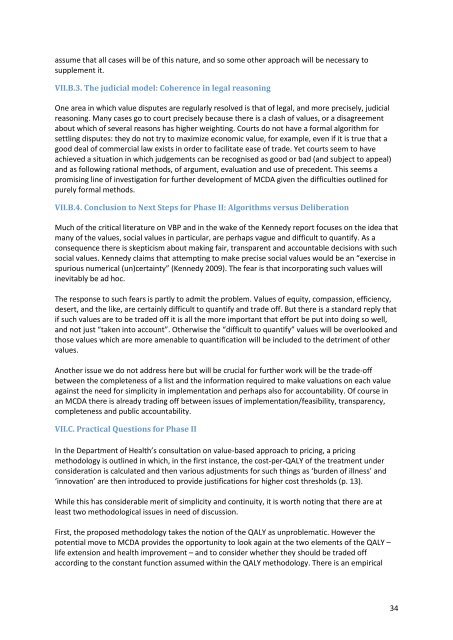What Values Should Count in Value Based Pricing for the NHS - UCL
What Values Should Count in Value Based Pricing for the NHS - UCL
What Values Should Count in Value Based Pricing for the NHS - UCL
You also want an ePaper? Increase the reach of your titles
YUMPU automatically turns print PDFs into web optimized ePapers that Google loves.
assume that all cases will be of this nature, and so some o<strong>the</strong>r approach will be necessary to<br />
supplement it.<br />
VII.B.3. The judicial model: Coherence <strong>in</strong> legal reason<strong>in</strong>g<br />
One area <strong>in</strong> which value disputes are regularly resolved is that of legal, and more precisely, judicial<br />
reason<strong>in</strong>g. Many cases go to court precisely because <strong>the</strong>re is a clash of values, or a disagreement<br />
about which of several reasons has higher weight<strong>in</strong>g. Courts do not have a <strong>for</strong>mal algorithm <strong>for</strong><br />
settl<strong>in</strong>g disputes: <strong>the</strong>y do not try to maximize economic value, <strong>for</strong> example, even if it is true that a<br />
good deal of commercial law exists <strong>in</strong> order to facilitate ease of trade. Yet courts seem to have<br />
achieved a situation <strong>in</strong> which judgements can be recognised as good or bad (and subject to appeal)<br />
and as follow<strong>in</strong>g rational methods, of argument, evaluation and use of precedent. This seems a<br />
promis<strong>in</strong>g l<strong>in</strong>e of <strong>in</strong>vestigation <strong>for</strong> fur<strong>the</strong>r development of MCDA given <strong>the</strong> difficulties outl<strong>in</strong>ed <strong>for</strong><br />
purely <strong>for</strong>mal methods.<br />
VII.B.4. Conclusion to Next Steps <strong>for</strong> Phase II: Algorithms versus Deliberation<br />
Much of <strong>the</strong> critical literature on VBP and <strong>in</strong> <strong>the</strong> wake of <strong>the</strong> Kennedy report focuses on <strong>the</strong> idea that<br />
many of <strong>the</strong> values, social values <strong>in</strong> particular, are perhaps vague and difficult to quantify. As a<br />
consequence <strong>the</strong>re is skepticism about mak<strong>in</strong>g fair, transparent and accountable decisions with such<br />
social values. Kennedy claims that attempt<strong>in</strong>g to make precise social values would be an “exercise <strong>in</strong><br />
spurious numerical (un)certa<strong>in</strong>ty” (Kennedy 2009). The fear is that <strong>in</strong>corporat<strong>in</strong>g such values will<br />
<strong>in</strong>evitably be ad hoc.<br />
The response to such fears is partly to admit <strong>the</strong> problem. <strong><strong>Value</strong>s</strong> of equity, compassion, efficiency,<br />
desert, and <strong>the</strong> like, are certa<strong>in</strong>ly difficult to quantify and trade off. But <strong>the</strong>re is a standard reply that<br />
if such values are to be traded off it is all <strong>the</strong> more important that ef<strong>for</strong>t be put <strong>in</strong>to do<strong>in</strong>g so well,<br />
and not just “taken <strong>in</strong>to account”. O<strong>the</strong>rwise <strong>the</strong> “difficult to quantify” values will be overlooked and<br />
those values which are more amenable to quantification will be <strong>in</strong>cluded to <strong>the</strong> detriment of o<strong>the</strong>r<br />
values.<br />
Ano<strong>the</strong>r issue we do not address here but will be crucial <strong>for</strong> fur<strong>the</strong>r work will be <strong>the</strong> trade‐off<br />
between <strong>the</strong> completeness of a list and <strong>the</strong> <strong>in</strong><strong>for</strong>mation required to make valuations on each value<br />
aga<strong>in</strong>st <strong>the</strong> need <strong>for</strong> simplicity <strong>in</strong> implementation and perhaps also <strong>for</strong> accountability. Of course <strong>in</strong><br />
an MCDA <strong>the</strong>re is already trad<strong>in</strong>g off between issues of implementation/feasibility, transparency,<br />
completeness and public accountability.<br />
VII.C. Practical Questions <strong>for</strong> Phase II<br />
In <strong>the</strong> Department of Health’s consultation on value‐based approach to pric<strong>in</strong>g, a pric<strong>in</strong>g<br />
methodology is outl<strong>in</strong>ed <strong>in</strong> which, <strong>in</strong> <strong>the</strong> first <strong>in</strong>stance, <strong>the</strong> cost‐per‐QALY of <strong>the</strong> treatment under<br />
consideration is calculated and <strong>the</strong>n various adjustments <strong>for</strong> such th<strong>in</strong>gs as ‘burden of illness’ and<br />
‘<strong>in</strong>novation’ are <strong>the</strong>n <strong>in</strong>troduced to provide justifications <strong>for</strong> higher cost thresholds (p. 13).<br />
While this has considerable merit of simplicity and cont<strong>in</strong>uity, it is worth not<strong>in</strong>g that <strong>the</strong>re are at<br />
least two methodological issues <strong>in</strong> need of discussion.<br />
First, <strong>the</strong> proposed methodology takes <strong>the</strong> notion of <strong>the</strong> QALY as unproblematic. However <strong>the</strong><br />
potential move to MCDA provides <strong>the</strong> opportunity to look aga<strong>in</strong> at <strong>the</strong> two elements of <strong>the</strong> QALY –<br />
life extension and health improvement – and to consider whe<strong>the</strong>r <strong>the</strong>y should be traded off<br />
accord<strong>in</strong>g to <strong>the</strong> constant function assumed with<strong>in</strong> <strong>the</strong> QALY methodology. There is an empirical<br />
34
















